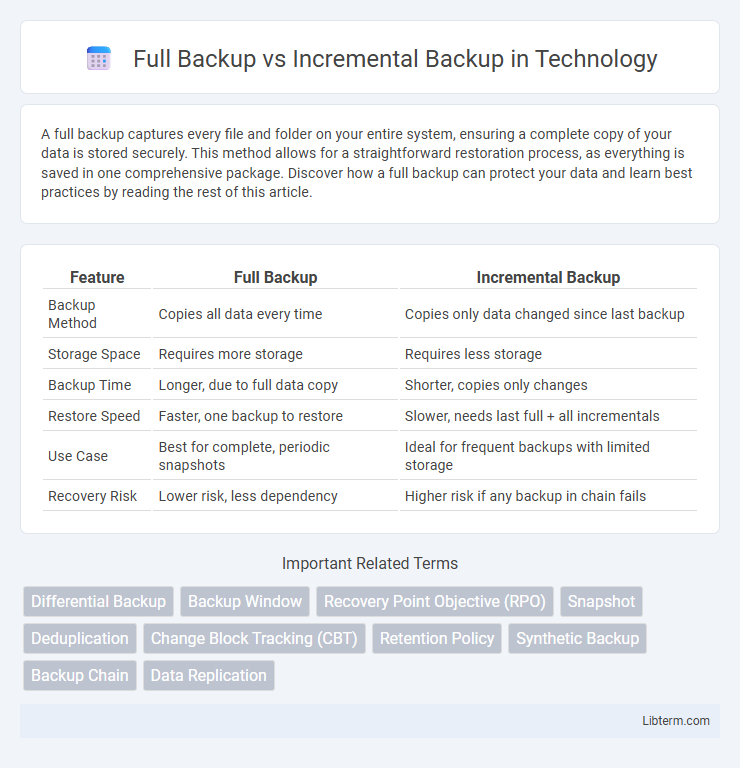A full backup captures every file and folder on your entire system, ensuring a complete copy of your data is stored securely. This method allows for a straightforward restoration process, as everything is saved in one comprehensive package. Discover how a full backup can protect your data and learn best practices by reading the rest of this article.
Table of Comparison
| Feature | Full Backup | Incremental Backup |
|---|---|---|
| Backup Method | Copies all data every time | Copies only data changed since last backup |
| Storage Space | Requires more storage | Requires less storage |
| Backup Time | Longer, due to full data copy | Shorter, copies only changes |
| Restore Speed | Faster, one backup to restore | Slower, needs last full + all incrementals |
| Use Case | Best for complete, periodic snapshots | Ideal for frequent backups with limited storage |
| Recovery Risk | Lower risk, less dependency | Higher risk if any backup in chain fails |
Introduction to Data Backup Strategies
Full backup captures the entire dataset, providing a comprehensive copy for complete restoration, while incremental backup saves only the changes since the last backup, optimizing storage and speed. Organizations use full backups for reliability and incremental backups for efficiency, balancing resource use and recovery time objectives (RTO). Effective data backup strategies combine both methods to ensure data integrity, minimize downtime, and align with business continuity plans.
What is a Full Backup?
A full backup is a comprehensive data protection method that copies all selected files and system data in their entirety, allowing complete restoration from a single backup set. It captures an exact snapshot of the entire dataset at a specific point in time, ensuring maximum data security and recovery reliability. Full backups require more storage space and time compared to incremental backups but simplify the recovery process.
What is an Incremental Backup?
An incremental backup captures only the data that has changed since the last backup, significantly reducing storage space and backup time compared to full backups. This method creates multiple backup sets that require the last full backup and all incremental backups to restore the entire dataset. Incremental backups are ideal for environments needing frequent backups with minimal impact on system resources.
Key Differences Between Full and Incremental Backup
Full backup creates a complete copy of all selected data, ensuring comprehensive restoration but requiring significant storage space and time. Incremental backup captures only the changes made since the last backup, optimizing storage efficiency and speeding up backup processes while increasing restoration complexity. The primary differences lie in storage requirements, backup duration, and recovery speed, with full backup favoring simplicity in restores and incremental backup prioritizing resource efficiency.
Advantages of Full Backup
Full backups provide comprehensive data protection by capturing all files and system information in a single image, ensuring complete restoration capability. This method simplifies recovery processes since all data resides in one backup set, reducing recovery time objectives (RTO). Full backups also enhance data integrity verification, making them ideal for critical systems requiring consistent, reliable recovery points.
Advantages of Incremental Backup
Incremental backup significantly reduces storage space by saving only the data modified since the last backup, enhancing efficiency for frequent backup schedules. This method shortens backup time, minimizing system resource usage and reducing operational downtime. Incremental backups also enable faster recovery by allowing restoration from the most recent data changes without reprocessing the entire dataset.
Disadvantages of Full Backup
Full backups consume significant storage space and require extended time to complete, leading to longer backup windows and potential disruption in operations. They increase network bandwidth usage, which can slow down overall system performance during the backup process. Restoring data from full backups can be straightforward but managing large volumes of backups often results in higher storage costs and resource demands.
Disadvantages of Incremental Backup
Incremental backup disadvantages include longer recovery times since data restoration requires the last full backup plus all subsequent incremental backups, increasing complexity and risk of data loss if any incremental file is corrupted or missing. They consume less storage initially but can cause slower backup verification and restoration processes compared to full backups. Incremental backups also demand more meticulous management and monitoring to ensure backup consistency and integrity over time.
Choosing the Right Backup Method for Your Needs
Full backups capture all data, providing a comprehensive restore point but requiring significant storage and time. Incremental backups save only changes since the last backup, optimizing storage and speed but complicating recovery due to multiple backup sets. Selecting the right method depends on data criticality, backup window constraints, and available storage resources to balance recovery speed and resource efficiency.
Conclusion: Full Backup vs Incremental Backup
Full backups create a complete copy of all data, providing comprehensive recovery at the cost of longer storage time and higher resource use. Incremental backups capture only the changes since the last backup, optimizing storage efficiency and speed while requiring the entire backup chain for restoration. Choosing between full and incremental backups depends on balancing recovery time objectives, storage limitations, and backup frequency needs.
Full Backup Infographic

 libterm.com
libterm.com